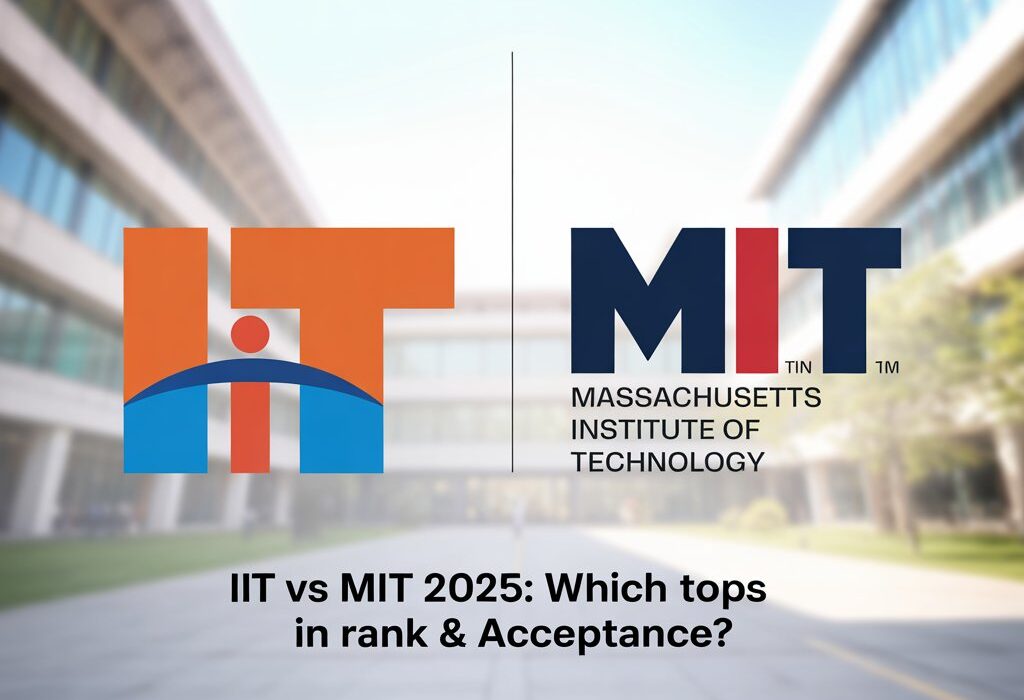When it comes to top-tier engineering and technology institutes, few names carry as much weight as the Indian Institutes of Technology (IITs) and the Massachusetts Institute of Technology (MIT).
While IITs are India’s pride with campuses like IIT Bombay, IIT Delhi, and IIT Madras leading the charge, MIT in the U.S. consistently tops global rankings for its cutting-edge research, innovation, and academic excellence.
In 2025, the IIT vs MIT 2025 debate is more relevant than ever. With globalization breaking barriers and students aspiring for world-class education, understanding the nuances between these two educational giants is essential.
The rise in international applications and cross-border academic collaborations has made this comparison both timely and critical for students making life-altering decisions.
IIT vs MIT 2025 scenario based on important metrics such as global rankings, acceptance rates, curriculum, student life, research opportunities, and long-term career outcomes.
Whether you’re a student in India weighing your options or an international aspirant considering both institutions, this guide—brought to you by Genius Study Abroad—will help you navigate this important decision with clarity and confidence.
Global Rankings 2025: IIT vs MIT
When comparing IIT vs MIT 2025, global university rankings speak volumes about institutional prestige and academic impact.
According to the QS World University Rankings 2025, the Massachusetts Institute of Technology (MIT) has once again claimed the #1 position globally, continuing its legacy of innovation, research excellence, and technological advancement.
Conversely, India’s top universities, the Indian Institutes of Technology (IITs), have achieved remarkable progress.
IIT Delhi is placed 150th, closely behind IIT Bombay, which is ranked 118th among Indian institutes. These rankings place them firmly in the global top 150, reflecting their growing influence on the world stage.
When looking beyond the top two, other IITs like IIT Madras, IIT Kanpur, and IIT Kharagpur fall within the top 250-400 range globally.
While these numbers may seem distant from MIT’s position, it’s important to recognize the difference in global exposure, funding, and historical establishment between the institutions.
The IIT vs MIT 2025 debate isn’t just about numbers—it’s also about choosing the right academic and research environment that aligns with a student’s long-term goals.
While MIT excels in cutting-edge innovation, IITs offer a robust education system at a fraction of the cost, making them attractive for top Indian talent.
At Genius Study Abroad, we help students explore such global opportunities by comparing institutions, programs, and career outcomes so they can make informed decisions for a successful academic future.
So when you’re weighing IIT vs MIT 2025, look beyond rankings—look at fit, funding, future goals, and the path that best suits you.
Acceptance Rates & Admission Processes

When comparing IIT vs MIT 2025, one of the most critical aspects to consider is their acceptance rates and admission processes, which reveal how competitive and unique each institution truly is.
Because of the intense rivalry among applicants from all over the world, MIT’s admittance rate in 2025 is approximately a highly selective 4.5%.
The admissions process at MIT is holistic—beyond just stellar SAT or ACT scores, it deeply evaluates essays, extracurricular activities, and personal interviews. This approach helps MIT find not only academically brilliant students but also those with creativity, leadership, and a drive to innovate.
On the other hand, IITs in India are known for their rigorous selection method through the JEE Advanced exam, which is considered one of the toughest engineering entrance exams globally. With an acceptance rate ranging from 0.5% to 2.6%, gaining admission to an IIT is arguably even more competitive by percentage terms.
Unlike MIT’s broader application process, IIT admissions rely heavily on this one exam, making preparation an intense and highly focused journey for aspiring engineers.
Understanding these differences in acceptance rates and admission processes is essential for students deciding between IIT and MIT. For personalized guidance and expert counseling on navigating these pathways, Genius Study Abroad is here to help you make the best decision for your future.
Academic Programs & Curriculum
When comparing IIT vs MIT 2025, academic programs and curriculum play a crucial role in deciding the right fit for aspiring students.
MIT offers an impressive range of 57 undergraduate majors and 59 minors, with a strong focus on interdisciplinary fields such as Artificial Intelligence, Robotics, and Design. This breadth allows students to explore cutting-edge areas, often combining disciplines to solve complex problems.
For example, MIT’s AI research is consistently ranked among the top globally, contributing to innovations in autonomous systems and machine learning.
On the other hand, IITs primarily focus on engineering and technology programs, rooted deeply in traditional technical education.
However, the landscape is evolving — IITs are expanding their curriculum to include more management and applied sciences courses, reflecting industry demands and the growing entrepreneurial culture among Indian students.
This difference in academic breadth is a key point in the IIT vs MIT 2025 debate. While IIT offers solid foundations with a strong technical focus, MIT’s diverse and interdisciplinary curriculum often gives its students broader exposure and flexibility.
Understanding these differences helps you frame the debate sensibly, but ultimately, your career aspirations will determine whether you choose MIT or IIT.
For those looking for guidance in navigating this important decision, Genius Study Abroad provides expert counseling to help students align their academic aspirations with the right institution.
This insight into academic programs is just one of many factors in the ongoing IIT vs MIT 2025 comparison.
Cost of Education & Financial Aid

When comparing IIT vs MIT 2025, one of the most critical factors for students and families is the cost of education and available financial aid. Understanding this can help you make an informed decision about where to pursue your engineering dreams.
At MIT, the annual cost of attendance for the academic year is approximately $85,960 (around ₹70 lakh). This figure includes tuition, fees, room, board, and other expenses.
However, MIT is renowned for its generous need-based financial aid, ensuring that many students attend with little or no tuition cost depending on their family income. In fact, a significant percentage of MIT students graduate debt-free thanks to this comprehensive aid system.
On the other hand, IITs in India offer a much more affordable education, with tuition fees typically ranging between ₹1 to ₹2 Lakhs per year.
While this is significantly lower compared to MIT, IITs also provide various scholarships and fee waivers for eligible students, especially those from economically weaker sections or with outstanding academic records.
So, when evaluating IIT vs MIT 2025, the financial investment is a major consideration. While MIT’s costs are higher, the availability of substantial financial aid can level the playing field for many talented students. Conversely, IIT’s lower tuition fees make it accessible to a broader population without the need for large financial support.
For students looking to explore opportunities at both institutes, Genius Study Abroad offers expert guidance on admissions, scholarships, and financial planning, helping you choose the best path suited to your goals and budget.
Alumni Network & Global Influence
When comparing IIT vs MIT 2025, one of the most striking differences lies in the alumni network and its global impact.
MIT boasts an impressive list of alumni, including 100+ Nobel laureates, pioneers like Kofi Annan and Buzz Aldrin, and the founders of global tech giants such as Dropbox and Qualcomm.
Its graduates dominate STEM industries, venture capital, and academic research worldwide, often shaping innovation and policy on an international scale.
IITs, on the other hand, have built a powerful legacy of their own. The success of the institute in generating world-renowned tech leaders is demonstrated by alumni like Sundar Pichai, the CEO of Google, and Arvind Krishna, the CEO of IBM.
Many IITians have also become successful entrepreneurs, launched unicorn startups, and contributed to public service and policymaking in India and beyond.
In the IIT vs MIT 2025 debate, both institutions prove the power of their alumni networks—but in different ways. While MIT’s influence is deeply rooted in research and innovation at a global level, IIT’s strength lies in its ability to produce adaptable leaders who excel across sectors.
At Genius Study Abroad, we help students understand these critical differences so they can make informed decisions about their educational futures.
Whether you’re inspired by MIT’s global research ecosystem or IIT’s leadership legacy, choosing between IIT vs MIT 2025 should be aligned with your long-term goals.
Campus Life & Student Experience
When it comes to campus life, the IIT vs MIT 2025 comparison reveals two distinctly enriching yet unique student experiences.
At MIT, the environment is buzzing with innovation and diversity. With students from over 120 countries, MIT fosters a truly global community. The focus here extends beyond textbooks—students engage in cutting-edge research even at the undergraduate level.
Whether it’s robotics labs, AI centers, or entrepreneurship hubs like The Martin Trust Center, students are surrounded by world-class facilities and opportunities. According to the 2024 QS Rankings, over 89% of MIT students participate in research before graduation—a testament to its research-centric culture.
On the other hand, IITs in India are known for their academically intense atmosphere, especially in engineering and technology. In the IIT vs MIT 2025 comparison, IITs offer a more traditional yet intellectually stimulating experience.
Despite the rigorous coursework, student life isn’t all about academics. Cultural festivals like IIT Bombay’s Mood Indigo or IIT Delhi’s Rendezvous draw crowds from across the country, blending talent, creativity, and community.
Students at IITs form tight-knit communities, often bonding over shared academic pressures and late-night brainstorming sessions. Hostel life is integral to the IIT experience, fostering friendships that last a lifetime.
When evaluating IIT vs MIT 2025, campus life plays a crucial role. While MIT leans more towards innovation and global exposure, IITs emphasize discipline, academic rigor, and cultural richness. Both nurture future leaders—just in their own unique ways.
Want to explore your study options at MIT or compare them with top Indian institutes like IIT? Genius Study Abroad can help you plan your journey with personalized guidance and expert support.
Career Opportunities & Placements

When it comes to career outcomes, the comparison of IIT vs MIT 2025 becomes even more compelling.
In terms of employability, MIT (Massachusetts Institute of Technology) is frequently ranked among the best universities in the world. The QS Graduate Employability Rankings frequently place MIT at the top.
Graduates from MIT enjoy median starting salaries upwards of $100,000 per year, with top recruiters including Google, Apple, Microsoft, and Goldman Sachs. The university’s Career Advising & Professional Development (CAPD) team ensures students are well-prepared through resume workshops, networking events, and internship support.
On the other hand, IITs (Indian Institutes of Technology) are seeing a sharp rise in global recognition. In the IIT vs MIT 2025 landscape, IIT graduates are increasingly securing international offers from companies in the US, Europe, and Southeast Asia.
In 2024, IIT Bombay recorded a highest package of ₹3.7 crore (international) and over 300+ international job offers across IITs. Domestic placements remain robust, with leading companies like TCS, Infosys, Google India, and Amazon actively recruiting.
While MIT may currently edge ahead in global corporate networks and salary benchmarks, IITs are closing the gap through strong alumni networks, government collaborations, and a rising number of international exchange programs.
If you’re planning your global education path and are comparing IIT vs MIT 2025, it’s important to consider not just reputation, but post-study opportunities and cultural alignment. At Genius Study Abroad, we help students navigate these crucial decisions with personalized guidance, updated data, and access to global mentors who’ve walked both paths.
Conclusion
When comparing IIT vs MIT 2025, it’s clear that both institutions offer world-class education, but they cater to different student experiences and academic goals.
While the Indian Institutes of Technology (IITs) are renowned for their rigorous entrance exams and producing top engineers within India, the Massachusetts Institute of Technology (MIT) is globally celebrated for its cutting-edge research, innovation ecosystem, and international diversity.
Key differences include global exposure, research funding, industry collaboration, and campus infrastructure.
For instance, MIT had a research budget of over $800 million in 2024, compared to a much smaller yet growing budget in top IITs like IIT Bombay or IIT Delhi. On the other hand, IITs are significantly more affordable, with annual tuition fees averaging ₹2.5 lakhs (~$3,000), while MIT’s tuition exceeds $55,000 per year.
However, similarities exist in their competitive spirit, alumni success, and emphasis on STEM education. Both institutions boast Nobel laureates, tech entrepreneurs, and CEOs among their graduates.
So, who should choose what?
- IITs might be better suited for students who aim to build a strong foundation in engineering within India, prefer a cost-effective education, and are looking for competitive entrance-driven admissions like JEE Advanced.
- MIT may be ideal for students seeking a global learning environment, interdisciplinary research, and access to international careers in tech, entrepreneurship, or academia.
Ultimately, the choice between IIT vs MIT 2025 should depend on your academic ambitions, financial capacity, and career goals. Both institutions can shape outstanding futures—what matters most is where you see yourself thriving.
At Genius Study Abroad, we help students navigate such life-changing decisions by offering expert counseling and support for both Indian and international institutions like IIT and MIT.



